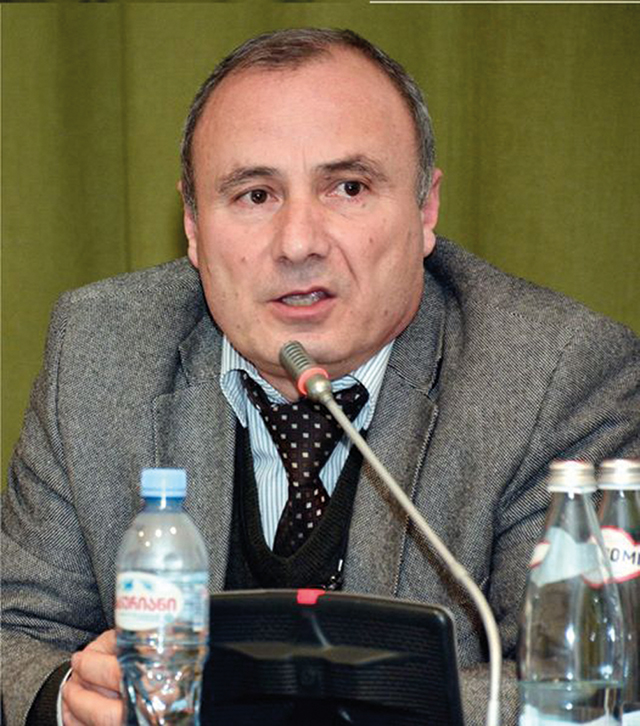Of late, climate change has resulted in a plethora of natural disasters in Georgia, especially the catchment basins of the Aragvi, Alazni, Enguri, and Rioni rivers, where natural disasters bring great destruction and economic losses, as well as human casualties.
To discuss these issues, GEORGIA TODAY sat down with Givi Gavardashvili, an academician of the Georgian National Academy of Science and an engineer-hydraulic technician, who has been working on perfecting the scientific aspects of environmental safety for almost half a century.

Please introduce our readers to your and the Institute’s scientific work.
I work in one of the oldest scientific and research organizations in the South Caucasus, founded in 1929, as the director of the Tsotne Mirtskhulava Water Management Institute of the Georgian Technical University, which will celebrate its 95th anniversary in 2024. Under my leadership, the institute cooperates with universities and scientific-research institutes of 33 countries of the world,” he notes, by way of introduction.
We are working on the strategic direction of the integrated management of water and soil resources for Georgia, with research into innovative water management and environmental protection measures, taking into account climate change. Alongside this, we’re looking into how to improve the scientific issues of hydromelioration using modern techniques and technologies. The most important priority for our country, however, is the education of young scientific personnel,” he says.

What can you tell us about your institution?
Our institute is one of the oldest scientific-research organizations, one in which world-class scientists such as academicians Tsotne Mirtskhulava and Otar Natishvili, both of whom were my teachers, and professors Mikheil Gagoshidze, Fridon Shatberashvili, Aleksandre Didebulidze – one of the Technical University’s founders, Ioseb Buachidze – former rector of the Technical University, Petre Mamradze (senior), Vakhtang Tevzadze, and Nino Varazashvili. It can be said that our institute is the oldest scientific-research organization in the South Caucasus region working in hydrotechnical structures and melioration directions – alma mater.
Tell us about your innovative projects in the direction of environmental protection.
In 2018-2022, the institute worked on grant project # FR17_615, a security risk assessment of vulnerable infrastructure during the formation of expected disasters, sponsored by the Shota Rustaveli National Science Foundation of Georgia. In the project, safety issues for the population, including a possible incident at the Zhinvali Earth Dam, were processed.
We established a framework for sustainability and risk management, testing and implementing the Critical Assets and Portfolio Risks Analysis (CAPRA) model, which provides a quantitative assessment of all the expected risks.
We had a memorandum of cooperation with the University of Maryland (USA), the scientific consultant of the project was Professor Bilal M. Ayyub, and I was the scientific supervisor of the grant project.
For the first time in our country, in 2018, the Shota Rustaveli National Science Foundation of Georgia announced a competition for grant projects with an invasive application, which envisioned the creation of scientific consortia with the involvement of non-governmental organizations.
We created a consortium that was made up of the Tsotne Mirtskhulava Water Management Institute as the leading organization, the organization in Category of Consultative Status with the Economics and Social Council (ECOSOC) of UN as a consultative status organization, the NNLE, “Environmental Protection Ecocenter,” and the Ltd Geological Environmental Agency. Our consortium won and was funded by the grant project AR-18-1244 – “Debris flow regulation elastic barrage” (Georgia Patent # P 20207068B).
Professor Eduard Kukhalashvili is the scientific head of the project, and I worked as the coordinator.
Within the framework of the grant project, among other tasks, the preparation of doctoral theses and the arrangement of innovative construction in nature were envisioned.
These tasks were successfully carried out. On February 22-23, 2022, at the Faculty of Construction of GTU, employees of the institute Keti Dadiani, Khatuna Kiknadze, Nana Beraya and Lika Maisaya successfully defended their doctoral theses and were awarded the academic degree of Doctor in Construction.
The preparation and public defense of these four doctoral theses within one grant project was the first of its kind in Georgia.
The “Debris flow elastic barrage” in nature was implemented in the Mtskheta-Mtianeti region, Dusheti municipality, near the village of Kvemo Mleti, in the bed of the Mleti River Gorge (1620 meters above sea level), which will not only reduce the destructive effect of flooding in the villages of Zemo and Kvemo Mleti but will also minimize the risks of flooding of the St. George Church in Mleti.
I’d like to express my gratitude to Mtskheta-Mtianeti Region Governor David Nozadze and Dusheti Municipality Mayor Manana (Matsatso) Narimanidze, and the local residents of Kvemo Mleti village, without whose consent and support the test-experimental structure of the “Debris flow elastic barrage” could not have been built.
The next innovative project that we implemented in 2021-2022 was supported by the Shota Rustaveli National Science Foundation of Georgia and funded by the World Bank (WB) grant project CARYS-19-305 – an innovative complex anti-snow avalanche measure (Patent of Georgia # 278). The project could not have been implemented without Davit Nozadze and the mayor of Kazbegi municipality, Bakur Avsajanishvili. In order to protect the Georgian Military Highway from the effects of snow avalanches, we built an innovative anti-snow avalanche construction in the alpine zone of the mountain slope in the vicinity of Gudauri, 2338 m above sea level.

Tell us about a hydromelioration project you have run.
In Didi Jikhaishi, Samtredia, at the agricultural college of GTU, we organized a scientific and educational stand of three-tiered combined drainage for the implementation of scientific grant projects and training programs on drying wetland soils. GTU doctoral student Maka Guguchia successfully defended her doctoral dissertation using the above-mentioned stand.
What can you tell us about innovative technologies?
On August 24, 2022, a scientific seminar was held at the Tsotne Mirtskhulava Water Management Institute of the Georgian Technical University on the topic: “use of innovative technologies – concrete canvas in water management, environmental protection, and hydromelioration.” The presentation was made by Ildar Yamaliev, Director of Concrete Canvas Company, and Ian Woodcock, Co-Founder of Concrete Canvas Company, England. After the scientific seminar, an example of the practical use of concrete canvas was held in the hydrotechnical laboratory of the institute.
What modern scientific literature have you been involved in creating?
We actively cooperate with such world-famous publications as Lambert in Germany and “Cambridge Scholars Publishing” in England. In 2019-2021, Lambert published a monograph with the co-authorship of Eduard Kukhalashvili, Shorena Kupreishvili, and Nana Beraya named “Expected Risks of Cohesive Debris Flows and Fighting Against Them” in eight foreign languages (English, Spanish, Dutch, Italian, French, German, Polish and Portuguese). In 2022, Cambridge Scholars Publishing published my monograph “Predicting Erosive and Debris Flow Processes and the Innovative Measures to Control Them” in English, which is currently on sale on Amazon.
Co-authored with the scientists of the institute, Irine Iordanishvili, Inga Iremashvili and Kote Iordanishvili, we published an explanatory dictionary of hydroengineering terminology for the first time in our country (“Universal” publishing house, Tbilisi, 2022, format A4, 371 p.). The work is dedicated to the 100th anniversary of GTU.
Co-authored with the Rector of GTU, Professor Davit Gurgenidze, in 2022, the publishing house Technical University published a monograph “Basics of ecological-economic theory of integrated management of natural resources” Tbilisi, 2022, 230 pages, which can be used as a desk guide for students and young scientists. The monograph is also dedicated to the 100th anniversary of GTU.
What can you tell us about the future of the Institute’s work and the 2023 plan?
The institute, together with universities in the USA, Georgia, Ukraine, Bulgaria, Romania and Turkey, prepared a NATO grant project. The project directory is the California State University and we are waiting for information about project funding. The project concerns the ecological safety of the Black Sea and developing digital models against cyber-attacks. We also developed a project on innovative methods of risk assessment of natural disasters and submitted it to the United Nations. We expect a response from New York this spring.
The scientific and research work at the institute has already moved to the level of Euro standards, a fact ensured by the constant updating of material and equipment at the institute. We have purchased drones, high-precision GPS, and installed mini-meteorological stations of international standard at our two research scientific bases in Poti and Karaleti village near Gori, from which meteorological data in Tbilisi is updated online every hour. Large-scale modeling of sea waves is also actively underway in the institute’s hydrotechnical laboratory, which is led by Irine Iordanishvili, Doctor of Technical Sciences, Head of the Seas and Reservoirs Research Department.














